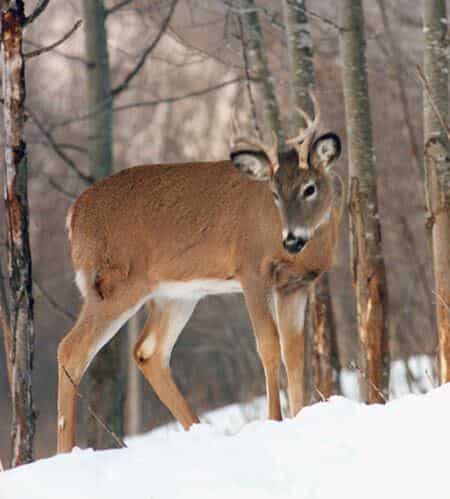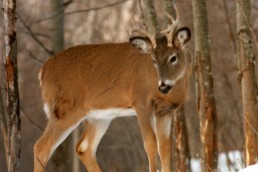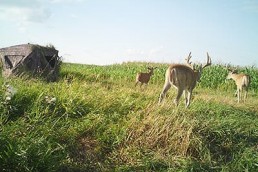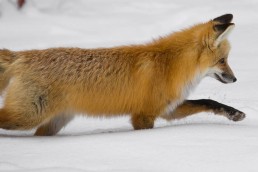Hunting Older Bucks in Wolf Country
SHARE THIS POST
Matching wits with older wolf country bucks was the name of the game during our past firearm hunting season in northeastern Minnesota. This year there were no 1-1/2- (yearlings) to 3-1/2-year-old bucks in our “bucks only” hunting area. All we had in the 5-square miles, in which we have been hunting for 26 years, were four 4-1/2- to 6-1/2-year-old bucks (and only two cow moose). All were dominant breeding bucks that have been successfully avoiding us since they were old enough to live in the wilds on their own. Even if it was possible for the 11 of my hunting partners and me to take all four of these bucks in 2015—which would have been very unlikely (taking one of four or five of bucks of this caliber per year is very good hunting)—we refused to set our sights on such an accomplishment. Taking more than two of them could be as disastrous as another severe winter. Such bucks are needed to breed does and pass on superior genetics. Nope, we figured, two bucks would be enough this year, if that. We had never taken two dominant breeding bucks in one season before. Most of the bucks we tagged were non-breeding bucks lower in the local pecking orders of bucks. This year we’d enjoy the hunt, not the taking of bucks.

We were surprised to discover a significant increase in numbers of mature does in our hunting area this year. These were not deer that grew up in this area. They were fully-grown does capable of giving birth to twin fawns (following a mild winter like the one we had last year). They had migrated into our area from somewhere else after snowmelt last spring, adopting quite a few doe home ranges that had been unoccupied by does since 2011 or 2012.
Also a surprise was the unusual number of fawns still surviving in November in our area—nine of them. It wasn’t attributable to a lack of wolves; it’s only attributable to an increased number of mature does. Most of our mature does (2 1/2 years of age or older) gave birth to twin fawns last May. By November 1, roughly half had single fawns only (before and after numbers made obvious by tracks, droppings and sightings), meaning, as during previous years since 1990 our wolves were still taking three of four fawns by November.
We found fresh wolf tracks daily wherever we hunted. We often heard them howl midday, a sure sign they were being forced to hunt midday (which used to be very unusual) due to a shortage of food. Like several things that were different last year and this year, this year’s shortage of food might be attributable to the fact that our wolves had not yet formed a pack by the end of the firearm hunting season (November 22). By this date, even fawns can outrun wolves. From November through snowmelt in spring, wolves need the advantages provided by cooperative hunting by packs to regularly take fleeting whitetails. All the fresh wolf tracks we found while hunting this year were made by single adults: five-inchers made by our alpha female and six-inchers made by our alpha male. In the past, our wolves had always formed a pack by November 8, thereafter traveling everywhere together. Last year the pack consisted of only four adult wolves. A decade or more ago the pack commonly included six to eight adult wolves and two to three pups. This does not mean there are currently fewer wolves in this region. Today there are four groups of wolves within hearing (howling) where there once was only one group. Two severe winters and too many wolves in Minnesota’s Arrowhead have obviously had a terrible affect on these mighty predators and their prey.
Our whitetails have also undergone some changes, particularly in social behavior, which may in turn be attributable to year around hunting by wolves. From 1970 through 2013, mature does with young in forest regions that I have studied aggressively defended their home ranges from intrusions by other does with young, kicking and slashing with fore-hoofs, with intent to wound and chasing offenders off-range. 2014 was the first year we began seeing small herds of mature does with young regularly feeding and bedding together spring through November. Ever since whitetails began adapting to year-round residences in farm regions 50-some years ago, such herds have long been common there but not in the woods. My wife Jene and I studied and photographed larger groups of does with young in Texas, New Mexico and Arizona beginning in 1996. I have no idea how long such groups had been in existence there.
The tendency for does to form small herds in summer and fall is probably made easy by the fact that whitetails have been congregating in small to large numbers in wintering areas (deer yards) that provide adequate browse, cover and improved odds of survival for 10,000 years. Congregated deer are much more difficult for predators to approach without being seen, heard or smelled. Congregated deer keep winter trails usable, providing access to successive new sources of food and enabling whitetails to flee with great speed when necessary. Congregated whitetails also enable experienced mature deer to take advantage of younger deer, encouraging them or allowing them to move ahead and act as a form of radar, the first to be threatened by unidentified predators or human hunters when they are near. Our forest deer seem to be discovering congregating year around improves odds for survival.
Despite our much reduced deer numbers, our 2015 deer hunting season was enjoyable. Even though unseasonably warm temperatures kept our whitetails from moving much during daylight hours during our first five days of hunting, we still managed to see antlerless deer feeding between first light and 9 a.m., most mornings, meaning we had indeed selected stand sites where a dominant breeding buck seeking a doe in heat could show up at any moment. Besides, it was pleasant to sit in the woods on those balmy days.
Are you enjoying this post?
You can be among the first to get the latest info on where to go, what to use and how to use it!
Our wet Thursday was a great day to sleep in, listen to raindrops pattering on the tent roof, keep a fire crackling in the barrel woodstove, argue about politics (like my dad and his brothers did when I was young) and play lots of noisy games of cribbage. It was glorious to see 4 inches of newly fallen snow sticking to everything Friday morning. Our woods became a winter wonderland. I think our deer were pleased as well. Everyone saw deer that morning (including a fawn with 2-inch spikes). John got two shots at the Moose Mountain dominant breeding buck that morning (another story). Saturday was warm again. No one saw deer that day and Sunday was “Break Camp Day” for some of us, including me.
All in all, it was a good hunt, well worth all the time and effort we put into it. It may be some time before we can again take our usual four mature bucks per hunting season, but until then we will continue to look forward to each new season with the same anticipation, great expectations and joy. No matter what happens in the future, deer hunting will always be an enjoyable interlude in our lives.
Dr. Ken Nordberg has written more than 700 magazine articles and 12 books on the habits and hunting of whitetails and black bears, including the “Whitetail Hunters Almanac” series. He also produced “Doc’s Buck and Bear Hunting School” videos. His encyclopedic website is at drnordbergondeerhunting.com.
MWO
SHARE THIS POST
Did you enjoy this post?
You can be among the first to get the latest info on where to go, what to use and how to use it!
Dr. Ken Nordberg
Based on his 55 years of field research, Dr. Ken Nordberg has written more than 800 magazine articles, 12 books on whitetails—including the famous Whitetail Hunter’s Almanac series—five books on black bear hunting and produced Buck and Bear Hunting School videos. You may peruse his encyclopedic website with whitetail hunting tips: drnordbergondeerhunting.com, his blog: drnordbergondeerhunting.wordpress.com, or social media pages.



